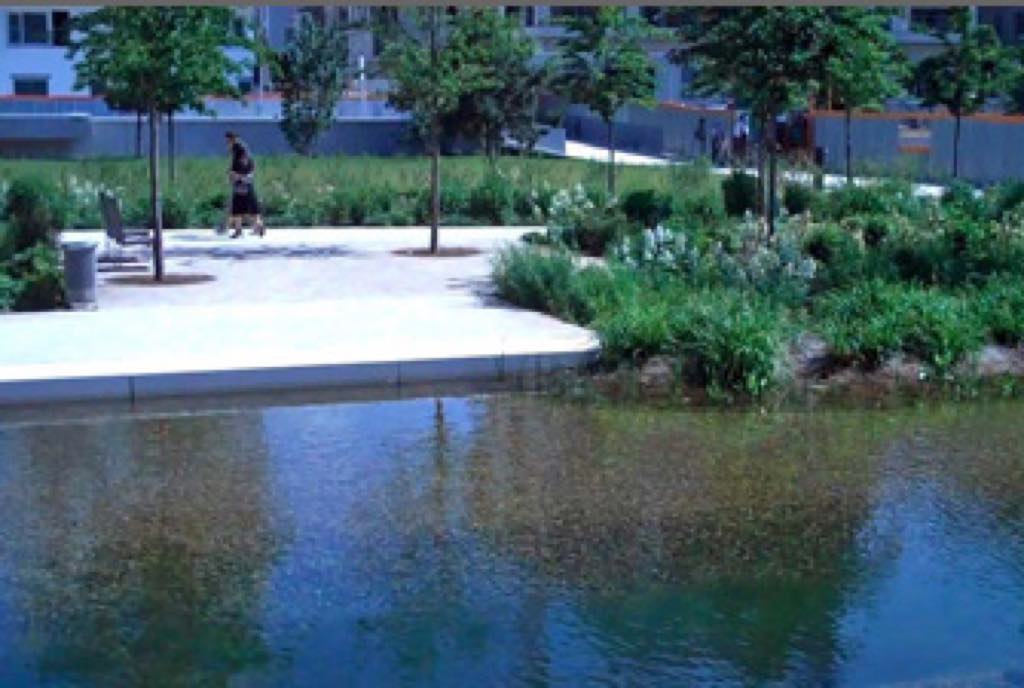
The global economy may still be reeling, but you’d never know it from a visit to the Paris suburb of Boulogne-Billancourt, where a small building boom is underway as part of the Ile Seguin-Rives de Seine redevelopment project, which is bringing new life to the Ile Seguin, once almost entirely covered by the massive Renault factory built in 1929, and the Trapèze area on the facing bank of the Seine, where more Renault factories once stood (auto production on the sites ended in 1992). The adjoining Pont de Sèvres district is also being rehabbed. The new neighborhood is called Rive de Billancourt.
This work in progress will be a mixed-use zone, with housing, offices, shops, parks, and educational and cultural facilities. Some are already in use while others – including an office building by the ubiquitous French architect Jean Nouvel – are still being built.
In the midst of all this activity, the city has decided to open two new parks, although neither is finished, so that the public can enjoy them even while construction continues around them.
On the Billancourt side of the Seine, the first half of the Parc de Billancourt has been completed. This innovative project designed by Paris-based Agence Ter will eventually cover 7 hectares (17.3 acres) when the second phase opens next year.
The originality of the park is that it seems to let the nearby Seine invade its spaces, forming an artificial arm of the river that can serve as an outlet for the waters of the river when it floods. The water, which is actually groundwater, seems to flow naturally into the park, forming ponds and marshy areas around “islands” with various environments — a flower-covered prairie, peat bog and orchard — which will shrink or grow in size depending on the level of the water table. The effect is of a soothing, poetic oasis amidst the surrounding buildings, whose geometric patterns are reflected in the water. Rainwater from the neighborhood is collected and used for watering the garden.
This high-concept garden has handsome wooden seats with a natural finish and clean modern design, but unfortunately, many single seats are placed in isolation far away from each other. In the Paris park I frequent, the benches are islands of sociability where both friends and strangers sit and chat. These isolated seats, which seem to be becoming the norm in new parks and renovated Métro stations, are probably meant to discourage bench sleeping, but they effectively encourage the standoffish tendencies of the French (I don’t know you, so I won’t acknowledge your existence).

Moving on to the second park: the Parc de Billancourt is connected with the Jardin de l’Ile Seguin by the handsome new Pont Renault, designed by Marc Barani, with lowered wooden walkways on either side to give pedestrians a sense of separation from the traffic.
The new park on the island, by landscape architect Michel Desvigne (what a great name for a landscape designer!), is truly a work in progress. For the moment, it is just a sketch of its future self, but it will remain open to the public as it evolves and as buildings, including a concert hall, go up around it. The park will consist of a series of different areas planted with local species like willows and elders, plus two large green spaces for picnicking and lolling on the grass. Yann Kersalé, who created the magical lighting for the garden of Paris’s Musée du Quai Branly, will be in charge of lighting the park.
The island was covered with community gardens before Renault arrived, and the new park will pay tribute to that long-lost role with its “jardins pédagogiques” (educational gardens), where both adults and children can learn about gardening. Concerts and other festivities will be held near the planned restaurant. The finished garden will have an area of 4 hectares and take up about a third of the island, which is now open to the public for the first time in its history. The overall architectural development of the island is being coordinated by – once again –Jean Nouvel.
It’s great to finally see something happening with the Ile Seguin, a nice piece of real estate in a prime location whose fate has been up in the air for nearly 20 years.
Reader Colin Eaton writes: “I agree with you on the park benches and single seats. They don’t even put any in some new Dublin public areas for fear that ‘undesirables’ might sit on them! This whole segregation and fear in society is self-imposed and damages sociability and social responsibility.”
Favorite